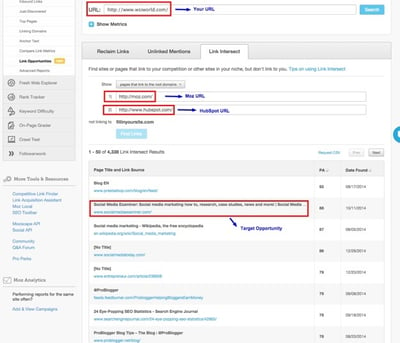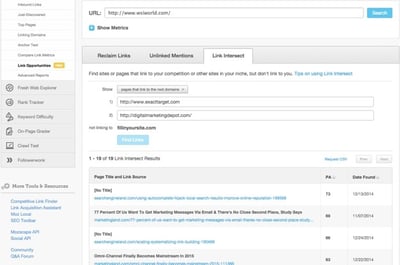3 Ways To Conduct Competitive Analysis

Summary: Here are some ways you can catch up with your competition if and (unless you’re lucky) when you hit a snag and fall behind them with competitive analysis.
Editor’s Note: This post was originally published in February 2015 and has been updated with additional content in September 2021.
Competitive analysis has become one of the most essential tools in any company’s digital marketing toolkit. We’ve talked about what companies can do to gain an edge over their competitors – but what about companies that, for whatever reason, fall behind their competitors? Whether it’s a lack of time, energy, resources or something else, when one company gains an edge, another company loses it. And that’s realistic – most of us in business know that there are always setbacks.
So what if you’ve lost your business’s competitive edge? And more importantly, how do you get it back? Since every business faces its own set of hurdles, it’s not about the setbacks; it’s how you trudge ahead and claw your way back to the top – no matter what.

Some companies just have it easy. Like Starbucks, they’ve always been atop the coffee world, haven’t they? Nope. Even Starbucks needed saving, and if they can come all the way back to where they are today, your business can too.
Here are some ways you can catch back up with your competition if and (unless you’re lucky) when you hit a snag and fall behind your competitors:
Understand Market Conditions
It is important to understand your competitor. Doing market research will enable you to help prepare for market changes and prevent you from being left behind by the competitor. Market research involves collecting and analyzing information about your customers and competitors. You can do market research in 3 different ways:
- Desktop research, which entails using existing information from the internet;
- Field research where you collect information by yourself using questionnaires and surveys; and,
- Hiring commercial agencies to carry out the research for you.
Assess what your competitors have to offer and analyze what they do better than you. Ask yourself if they offer more value than you. Do they meet the needs of their customers better than you meet the needs of your customers? Are the products, services, and experiences a higher quality than yours? These are some of the questions you can ask yourself in order to see where you can improve your company.
Identify Strengths and Weaknesses
A good competitive analysis helps you to identify the strengths and weaknesses of the competitor. You also need to catalog your strengths and weaknesses relative to direct and indirect competitors, because competition can come from anywhere. To achieve and maintain a competitive advantage in reaching and selling to your target market, you must possess a thorough knowledge of your competition. An in-depth competitive analysis will provide you with the following:
1. An understanding of how your existing and potential customers rate the competition.
2. Positive identification of your competitor’s strengths and weaknesses.
3. A mechanism to develop effective competitive strategies in your target market.
Design / Adjust Go-To-Market (GTM) Strategy
An effective GTM strategy requires a deep understanding of your ideal customer, market and competition, product offering and pricing, and channels necessary to reach your customers. Competitive analysis helps you to understand market dynamics so you can find an optimal way to reach your target customers.
Take an Honest and Realistic Approach to Competitive Analysis
If you’re reading this post and thinking, “Why are these guys being so negative about businesses?!” Bear with us until the end and give this a shot, and know that we don’t view the things we’re saying as negative – just pragmatic. It’s a tough world to do business in, but it’s impossible for companies who expect it to be easy (or stay easy if the stars do align).
If you’ve ever had any contact with super successful entrepreneurs or business owners, you’ve probably heard the phrase “don’t drink your own Kool-Aid.” That’s essentially what we mean when we say be honest and realistic about your business. Don’t let success fool you into a false sense of security because that’ll only compound things if and when they do get rough. The closer your perception of your business is to reality, the easier it’ll be to get back on track when the time comes.

Here’s an example: your company has experienced three straight years of sales growth. When year four starts off slower than expected, you don’t think anything of it because, hey, things will sort themselves out in quarter two. Before you know it, you’re in Q4 staring down a 50% decrease in sales for the year. So what really happened?
Once you realized there was a problem, you eventually discovered that a new competitor opened up shop around the same time you started taking a hit. The new guys used aggressive marketing tactics, offered a great customer experience, and set their prices just a hair lower than yours. Huh – no wonder you lost so many clients. All the information was there for you to see, but you weren’t looking for it because – you guessed it – you were sipping on your own Kool-Aid.
It’s difficult to balance pragmatism with the confidence and courage that it takes to run a successful business, but that’s how you know it’s the right thing to do!
Step Outside the Box with your Digital Marketing
Remaining self-aware of your company’s position amongst the competition is a good preventative measure, but what do you do if you’ve already fallen behind? It’s reasonable to assume that any company that is after your customers has done their research, so it’ll take some digital savvy to gain back your turf.
One of the best ways to even things up with your competitors is to eliminate any advantages they have over you. In the world of inbound marketing, every link a company has represents a small edge over other brands in the industry that don’t have the link. Moz just released an updated version of their Link Opportunities tool that does a great job at uncovering sites within your niche that are linking to two of your stronger competitors but not to you.
The ‘Link Intersect Tool’ is effective in two ways, and we’ll briefly run through both of them. For the first method, think of two heavyweights in your industry and plug their URLs into the tool. We’re using Moz and our partners over at HubSpot. These brands produce exceptional digital marketing resources, which is one of the primary goals of WSIWorld.com. Here’s what the results look like:

There are 4,338 pages that link to both Moz and HubSpot’s root domains but not WSI’s, so there’s plenty of opportunities out there. Many of these links come from places we’re aware of, like Social MediaExaminer, another big industry resource. On the other hand, there are a ton of not-so-obvious opportunities for us to target in our link outreach. For example, here’s a comprehensive list of tools and blogs for startup companies that we certainly aspire to be on, and there’s also the social media marketing page on Wikipedia, which is a link that seems obvious but isn’t something we thought to target.
If plugging in the big guns seems like an ambitious place to start, try Googling a keyword or phrase associated with your business and using the top two hits. We tried ‘digital marketing resources,’ a term that WSI ranks for on the first page of Google. Here are the results the Link Intersect tools spit out for that query:

Since we narrowed our search parameters, we got much more specific results, and a manageable list of 19 links to sift through. The most fruitful information in this set of data is that a number of articles on Search Engine Land and Marketing Land link to sites like WSIWorld.com.
The technical process of this exercise is simple, but there’s immense value in the resulting data, and you’ll be surprised at how many ideas you’ll get from looking at a list of industry sites that your competitors have beaten you to. It’s inspiring, humbling and definitely helps you to think outside the box.
How to Select Competitors for Analysis
It is always important to conduct a competitive analysis regularly in order to stay ahead of your competitor. You will need a lot of market research and insights about the industry that you are in and brands that you are competing with. You can use different search engines to collect information about your competitors. A good starting point would be to identify the competing company and to know its strengths and weaknesses.
Alternatives
What alternative can you offer your clients? Everyone would change something about their current product or service of use, so your mission is to find out what that is and offer this alternative that would make customers be more eager to support you instead. You have to have the same purpose as your competitor, but with different functionality.
Company Size
While doing your analysis, you should be looking at large companies as well as smaller companies. Only analyzing competitors of the same size as your company is a mistake. Doing a competitive analysis of other companies of all sizes, big and small, will give you a somewhat more accurate depiction of where your company falls on the spectrum. Always consider your relative position against your competitors. When compared to smaller businesses, your business might look further ahead. And when compared to bigger companies, it may look unreasonably smaller. You can have a more balanced view if you look at companies of both sizes.
Conduct a Competitive Analysis
It is important to understand the strengths and weaknesses of your competitor and compare them to those of your own company and then find a gap in your market. A competitive analysis is important because it will help you enhance your own business strategy. A competitive analysis should include your competitors’ features, market share, pricing, marketing, differentiators, strengths, weaknesses, geography, culture, and customer reviews. Doing a competitive analysis throughout the lifecycle of your company is important to stay up to date with the market trends and product offerings. A competitive analysis will give you a better idea of what services are currently available to your target market, and what ideas are being neglected.
Company Overview
The most important information that you will need to track your own growth is the founding date of the competitor’s company, as well as their employee count. How much has their company grown in all the time that it has been an operating company? Use this data to set yearly goals for yourself. Use sites such as LinkedIn, Owler, AngelList, and Crunchbase to find the “biographical” information of a company.
Employee Count
Jason Lemkin from SaaStr offers a formula that you can use to ballpark a revenue estimate, by just using the number of employees in the company. You can use LinkedIn to find the employee count of a company. Read more about this formula here.
Founding Year
As previously mentioned, you can use the founding year of your competitor to set your own goals, by knowing how much the competitor has achieved in a certain amount of time, from the founding of the company up until now. You can use the goals of the other company and what they have achieved, as a benchmark of your own goals and what you aim to achieve.
Investors
Finding a Venture Capitalist (VC) is helpful because a VC will provide you with capital if they think that your company exhibits high growth potential. If you see that a Venture Capitalist’s name is missing from the list of investors in your competing category, it would be wise to contact that VC because odds are that they might invest in your company.
Number of Customers
It will be difficult to find the exact number of customers that have supported your competitor. But, you can research the press releases of your competitor because companies usually boast online about reaching milestones in revenue and number of customers. Use Datanyze to see how many customer tags have used the competitor’s product.
Mergers and Acquisitions
One of the easiest ways for a company to enter a new market, or to get rid of a competitor, would be through merging or an acquisition. Do some research on the mergers and acquisitions of your competitor to get an idea of what direction they are moving in.
Organizational Strength and Weakness
You can find a lot of interesting feedback from employees on Glassdoor, as these employees anonymously submit their reviews. Naturally, there is no holding back on information, whether it is good or bad. You can uncover cultural aspects of the organization by reading what the employees have to say about senior leaders of the company. Some strengths cannot be replicated. If the founder has a large following on social media and is some influencer, then you cannot easily replicate that as it has to happen organically.
Pitfalls of Competitive Analysis in Marketing
It is important to know the main pitfalls that can throw off the insights of the competitor company that you have collected.
Competitive analysis is not a one-and-done exercise
It would not be very smart to not revisit or update your original insights. It is important to constantly keep an eye on your competitor because businesses are constantly changing. You cannot just do analysis once and then be done. You need to evolve with your competitor.
Confirmation bias is real
Confirmation bias is when you jump to a conclusion based on your assumptions. You cannot just depend on what you think you know of your competitors, let the data give you more concise answers instead of jumping to conclusions that can cost you. Be aware of your initial assumptions and test them.
Data without action is useless
Always act on the data that you have gathered. Make a strategic plan and execute it using the findings and marketing tactics that you have discovered while doing your research.
Working harder instead of smarter
It is so easy to gather up information around competitive analysis which means that you do not need to overcomplicate things for yourself. Make investments into tools that speed up the whole process and provide you with the important insights you need to make informed decisions in your business.
Starting without a direction
If you do not have a clear objective of why you are doing the competitive analysis, then you will make the process much harder and filled with much more work than is needed. Define your goal and be sure about what you want to learn from your competitor before you do your research.
Not accounting for market timing
Rather than researching the company’s approach at a single fixed point, focus on how the company has grown and progressed over time. Information on how your competitor has grown over time can be more meaningful than just knowing what their approach was in the early days of the business.
Let Competitive Analysis Improve The Customer Experience
If you look back at the Starbucks situation one more time, their recovery was completely based on improving the experience of their customers. They closed their stores to retrain their baristas. The new CEO invited customers to email him directly. They focused on creating a better website and having more of a presence on social media. And they made the tough decision to close over 600 locations, in essence admitting that opening them was a mistake.
Your business wouldn’t exist without customers, and at the end of the day, it won’t last if somebody else is willing to treat your customers better than you are. If you’ve fallen behind your competitors, chances are it’s because they realized this before you did. But if the stats and the history show us anything, it’s that just because you lose some customers, doesn’t mean they’re gone forever. Be honest about your business, think outside the box, improve the customer’s experience and go win them back!
Said another way, catching up with your competition boils down to doing a better job running your business (or marketing team, one-man operation, etc). You had the business sense, determination, and digital marketing know-how to build up a solid customer base, which means you have the skills to do it again. And when you do, you’ll never take your customers – or your success – for granted.
If you need help devising and applying an effective competitive analysis methodology, contact WSI to get started.
About the Author
Rick spent 20 years in the insurance industry in finance, primarily developing reporting platforms for B & C stakeholders. His ability to speak to consumers of data (managers and analysts) and translate their needs to programmers led him to start his own digital marketing agency in 2004 to develop data driven solutions for business owners.
The Best Digital Marketing Insight and Advice
We are committed to protecting your privacy. For more info, please review our Privacy and Cookie Policies. You may unsubscribe at any time.
Don’t stop the learning now!


